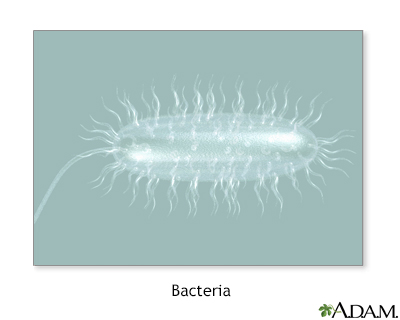Antibiotic resistance
Antimicrobials - resistance; Antimicrobial agents - resistance; Drug-resistant bacteria
Using antibiotics incorrectly can cause some bacteria to change or permit resistant bacteria to grow. These changes make bacteria stronger, so most or all antibiotic medicines no longer work to kill them. This is called antibiotic resistance. Resistant bacteria continue to grow and multiply, making infections harder to treat.
Images

I Would Like to Learn About:
Information
Antibiotics work by killing bacteria or keeping them from growing. Resistant bacteria keep growing, even when antibiotics are used. This problem is seen most often in hospitals and nursing homes.
New antibiotics are created to work against some resistant bacteria. But there are now bacteria that no known antibiotic can kill. Infections with such bacteria are dangerous. Because of this, antibiotic resistance has become a major health concern.
Causes of Antibiotic Resistance
Antibiotic overuse is a main cause of antibiotic resistance. This occurs in both humans and animals. Certain practices increase the risk of resistant bacteria:
- Using antibiotics when not needed. Most colds, sore throats, and ear and sinus infections are caused by viruses. Antibiotics don't work against viruses. Many people don't understand this and sometimes ask for antibiotics when not needed. This leads to an overuse of antibiotics. The Centers for Disease Control and Prevention (CDC) estimates that 1 in 3 antibiotic prescriptions are not needed.
- Not taking antibiotics as prescribed. This includes not taking all of your antibiotics, missing doses, or using leftover antibiotics. Doing so helps the bacteria learn how to grow in spite of the antibiotic. As a result, the infection may not fully respond to treatment the next time the antibiotic is used.
- Misuse of antibiotics. You should never buy antibiotics online without a prescription or take someone else's antibiotics.
- Exposure from food sources. Antibiotics are widely used in agriculture. This can lead to resistant bacteria in the food supply.
Why Antibiotic Resistance Is a Concern
Antibiotic resistance causes a number of problems:
- The need for stronger antibiotics with possibly severe side effects
- Fewer choices of antibiotics to treat antibiotic resistant bacteria
- More expensive treatment
- Harder-to-treat illness can spread from person to person
- More hospitalizations and longer stays
- Serious health problems, and even death
How Antibiotic Resistant Bacteria Spread
Antibiotic resistance can spread from person to person or from animals to humans.
In people, it may spread from:
- One patient to other patients or staff in a nursing home, urgent care center, or hospital
- Health care staff to other staff or to patients
- Patients to other people who come in contact with the patient
Antibiotic resistant bacteria may spread from animals to humans through:
- Food sprayed with water that contains antibiotic resistant bacteria from animal feces
Help Prevent Antibiotic Resistance
To prevent antibiotic resistance from spreading:
- Antibiotics should only be used as directed and when prescribed by a doctor.
- Unused antibiotics should be discarded safely.
- Antibiotics should not be prescribed or used for viral infections.
References
Centers for Disease Control and Prevention website. Antimicrobial resistance. www.cdc.gov/drugresistance/index.html. Updated December 17, 2021. Accessed September 6, 2022.
Centers for Disease Control and Prevention website. Antibiotic resistance questions and answers. www.cdc.gov/antibiotic-use/community/about/antibiotic-resistance-faqs.html. Updated August 23, 2022. Accessed September 6, 2022.
Opal SM, Pop-Vicas A. Molecular mechanisms of antibiotic resistance in bacteria. In: Bennett JE, Dolin R, Blaser MJ, eds. Mandell, Douglas, and Bennett's Principles and Practice of Infectious Diseases. 9th ed. Philadelphia, PA: Elsevier; 2020:chap 18.
BACK TO TOPReview Date: 4/9/2022
Reviewed By: Jatin M. Vyas, MD, PhD, Associate Professor in Medicine, Harvard Medical School; Associate in Medicine, Division of Infectious Disease, Department of Medicine, Massachusetts General Hospital, Boston, MA. Also reviewed by David C. Dugdale, MD, Medical Director, Brenda Conaway, Editorial Director, and the A.D.A.M. Editorial team.

Health Content Provider
06/01/2025
|
A.D.A.M., Inc. is accredited by URAC, for Health Content Provider (www.urac.org). URAC's accreditation program is an independent audit to verify that A.D.A.M. follows rigorous standards of quality and accountability. A.D.A.M. is among the first to achieve this important distinction for online health information and services. Learn more about A.D.A.M.'s editorial policy, editorial process and privacy policy. A.D.A.M. is also a founding member of Hi-Ethics. This site complied with the HONcode standard for trustworthy health information from 1995 to 2022, after which HON (Health On the Net, a not-for-profit organization that promoted transparent and reliable health information online) was discontinued. |
The information provided herein should not be used during any medical emergency or for the diagnosis or treatment of any medical condition. A licensed medical professional should be consulted for diagnosis and treatment of any and all medical conditions. Links to other sites are provided for information only -- they do not constitute endorsements of those other sites. © 1997- 2024 A.D.A.M., a business unit of Ebix, Inc. Any duplication or distribution of the information contained herein is strictly prohibited.
